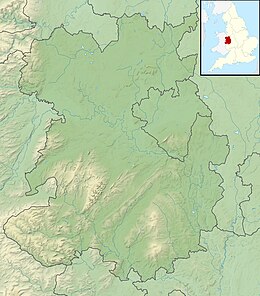User:Jokulhlaup/draftarticle11
Template
[edit]Google maps.[1]
Map
[edit]Floods
[edit]| Largest floods on the River Trent at Nottingham[2] | ||||||
|---|---|---|---|---|---|---|
| Rank | Date | Level at Trent Bridge | Peak Flow | |||
| m | ft | m3/s | cfs | |||
| 1 | February 1795 | 24.55 | 80.5 | 1,416 | 50,000 | |
| 2 | October 1875 | 24.38 | 80.0 | 1,274 | 45,000 | |
| 3 | March 1947 | 24.30 | 79.7 | 1,107 | 39,100 | |
| 4 | November 1852 | 24.26 | 79.6 | 1,082 | 38,200 | |
| 5 | November 2000 | 23.80 | 78.1 | 1,019 | 36,000 | |
| Normal / Avg flow | 20.7 | 68 | 84 | 3,000 | ||
The Trent is widely known for its tendency to cause significant flooding along its course, and there is a well documented flood history extending back for some 900 years. In Nottingham the heights of significant historic floods from 1852 have been carved into a bridge abutment next to Trent Bridge, with flood marks being transferred from the medieval Hethbeth bridge that pre-dated the existing 19th century crossing. Historic flood levels have also been recorded at Girton and on the churchyard wall at Collingham.[3][4][2]
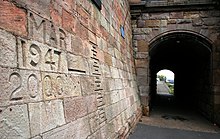
One of the earliest recorded floods along the Trent was in 1141, and like many other large historical events was caused by the melting of snow following heavy rainfall, it also caused a breach in the outer floodbank at Spalford. Some of the earliest floods can be assessed by using Spalford bank as a substitute measure for the size of a particular flood, as it has been estimated that the bank only failed when flows were greater than 1,000 cubic metres per second (35,000 cu ft/s), the bank was also breached in 1403 and 1795.[5]
Early bridges were vulnerable to floods, and in 1309 many bridges were washed away or damaged by severe winter floods, including Hethbeth Bridge. In 1683 the same bridge was partially destroyed by a flood that also meant the loss of the bridge at Newark. Historical archives often record details of the bridge repairs that followed floods, as the cost of these repairs or pontage had to be raised by borrowing money and charging a local toll.[4][5]
The largest known flood was the Candlemas flood of February 1795, which followed an eight week period of harsh winter weather, rivers froze which that meant mills were unable to grind corn, and then followed a rapid thaw. Due to the size of the flood and the ice entrained in the flow, nearly every bridge along the Trent was badly damaged or washed away. The bridges at Wolseley, Wychnor and the main span at Swarkestone were all destroyed.[6][7] In Nottingham, residents of Narrow Marsh were trapped by the floodwaters in their first floor rooms, boats were used to take supplies to those stranded. Livestock was badly affected, 72 sheep drowned in Wilford and ten cows were lost in Bridgford.[8] The vulnerable flood bank at Spalford was breached again, floodwaters spreading out across the low lying land, even reaching the River Witham and flooding Lincoln. Some 81 square kilometres; 31 square miles (20,000 acres) were flooded for a period of over three weeks.[4][9][10]
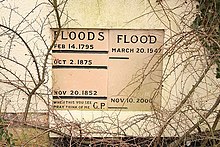
A description of the breach was given as follows:
"The bank is formed upon a plain of sandy nature, and when it was broken in 1795, the water forced an immense breach, the size of which may be judged from the fact that eighty loads of faggots and upwards of four hundred tons of earth were required to fill up the hole, an operation which took several weeks to complete."
The flood bank was subsequently strengthened and repaired, following further floods in 1824 and 1852.[9]
The principal flood of the 19th century and the second largest recorded, was in October 1875. In Nottingham a cart overturned in the floodwaters near the Wilford Road and six people drowned, dwellings nearby were flooded to a depth of 1.8 metres (6 ft). Although not quite as large as 1795 this flood devastated many places along the river, at Burton upon Trent much of the town was inundated, with flooded streets and houses, and dead animals floating past in the flood. Food was scarce, "in one day 10,000 loaves had to be sent into the town and distributed gratuitously to save people from famine".[11] In Newark the water was deep enough to allow four grammar school boys, to row across the countryside to Kelham. The flood marks at Girton show that this flood was only 4 inches lower than that of 1795, when the village was flooded to a depth of 0.91 metres (3 ft).[4]
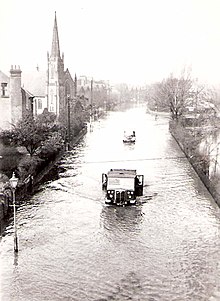
On the 17-18 March 1947 the Trent which had been rising ever higher, overtopped its banks in Nottingham. Large parts of the city and surrounding areas were flooded with 9,000 properties and nearly a hundred industrial premises affected some to first floor height. The suburbs of Long Eaton, West Bridgford and Beeston all suffered particularly badly.[12][13][14] Two days later, in the lower tidal reaches of the river, the peak of the flood combined with a high spring tide to flood villages and 2,000 properties in Gainsborough. River levels dropped when the floodbank at Morton breached, resulting in the flooding of some 200 square kilometres; 50,000 acres (78 sq mi) of farmland in the Trent valley.[15][14]
Flooding on the Trent can also be caused by the effects of storm surges independently of fluvial flows, a series of which occurred in October and November 1954, resulting in the worse tidal flooding experienced along the lower reaches. These floods revealed the need for a tidal protection scheme, which would cope with the flows experienced in 1947 and the tidal levels from 1954, and subsequently the floodbanks and defences along the lower river were improved to this standard with the works being completed in 1965.[15][16] In December 2013, the largest storm surge occurred on the Trent since the 1950s, when a low pressure weather system combined with high tides, and strong winds. The river levels generated by this surge overtopped the tidal flood defences in the area near Keadby and Burringham, flooding 50 properties.[17]
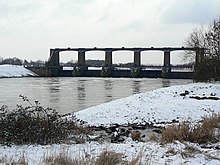
The fifth largest flood recorded at Nottingham occurred in November 2000, with widespread flooding of low lying land along the Trent valley, including many roads and railways. The flood defences around Nottingham and Burton constructed in the 1950s, following the 1947 event, stopped any major urban flooding, but problems did occur in undefended areas such as Willington and Gunthorpe, and again at Girton where 19 houses were flooded.[18] The flood defences in Nottingham that protect 16,000 homes and those in Burton where they prevent 7,000 properties from flooding were reassessed after this flood, and were subsequently improved between 2006 and 2012.[12][19]
MM1[4]
RMS[13]
cfmp3[15]
mercian2000[18]
Flood Marks

| Floods Levels at Trent Bridge[2] | |||
|---|---|---|---|
| Rank | Date | Level at Trent Bridge | |
| m | ft | ||
| 1 | February 1795 | 24.55 | 80.5 |
| 2 | October 1875 | 24.38 | 80.0 |
| 3 | March 1947 | 24.30 | 79.7 |
| 4 | November 1852 | 24.26 | 79.6 |
| 5 | February 1946 | 24.10 | 79.1 |
| 6 | January 1901 | 24.09 | 79.0 |
| 7 | May 1932 | 24.04 | 78.9 |
| 8 | December 1910 | 24.01 | 78.8 |
| 9 | December 1869 | 23.81 | 78.1 |
| 10 | July 1875 | 23.81 | 78.1 |
| 11 | November 2000 | 23.80 | 78.1 |
| 12 | January 1887 | 23.69 | 77.7 |
| 13 | 1857 | 23.49 | 77.1 |
| 14 | March 1864 | 23.41 | 76.8 |
| 15 | Normal Level | 20.7 | 68 |



On the northern abutment of the bridge, the high water marks reached by floods since 1852 have been carved into the stonework. This practice was started during the period when the Hethbeth bridge still existed, and those earlier marks were transferred onto the new bridge. To enable a comparison to be made with the peak levels, a graduated series of heights in feet above sea level has also been added.[2][20][3]
The highest flood mark is for the October 1875 flood, but the larger 1795 Candlemas flood, has been attributed with a height at the bridge of 24.55 metres (80.5 ft). Normal water level which is controlled by Holmes Sluices some 4 kilometres (2.5 mi) downstream, is 20.7 metres (68 ft).[20][21]
- Stone, Richard (2005). The River Trent. Phillimore. ISBN 1-86077-356-7.
refs
- ^ "Faro Inclinado" (Map). Google Maps. Retrieved 10 June 2015.
- ^ a b c d "Nottingham Left Bank Flood Alleviation Scheme Flood Risk Assessment" (PDF). broxtowe.gov.uk. 2001. p. 7. Retrieved 10 May 2013.
- ^ a b Macdonald, Neil (2012). "Reassessing flood frequency for the River Trent through the inclusion of historical flood information since AD1320" (PDF). cost-floodfreq.eu. p. 3. Retrieved 10 May 2013. Cite error: The named reference "hethbeth" was defined multiple times with different content (see the help page).
- ^ a b c d e Everard Leaver Guilford (1912). "Memorials of old Nottinghamshire" (Memorials of old Nottinghamshire. ed.). London: G. Allen. Retrieved 11 May 2013.
- ^ a b Brown, A.G.; Cooper, L; Salisbury, C.R.; Smith, D.N. (2001). "Late Holocene channel changes of the Middle Trent: channel response to a thousand-year flood record". Geomorphology. 39 (1). Elsevier: 69–82. doi:10.1016/S0169-555X(01)00052-6.
- ^ "Ridware study group". High Bridge crossing. Ridware history society. Retrieved 11 January 2014.
- ^ "Swarkestone" (PDF). Conservation Area Histories. South Derbyshire District Council. p. 1. Retrieved 11 January 2013.
- ^ "County floods remembered by Nottinghamshire Archives and Picture the Past". Press Releases. Nottinghamshire County Council. Retrieved 25 January 2014.
- ^ a b "Upper Witham IDB History". upperwitham-idb.gov.uk. Retrieved 11 May 2013.
- ^ Stone 2005, p. 59,62 harvnb error: multiple targets (2×): CITEREFStone2005 (help)
- ^ Williams, Frederick Smeeton (2012). The Midland Railway: Its Rise and Progress: A Narrative of Modern Enterprise 1876. Cambridge University Press. p. 329. ISBN 9781108050364.
- ^ a b "Nottingham Left Bank Scheme". Environment Agency. Retrieved 11 April 2013.
- ^ a b "1947 U.K. River Floods:60-Year Retrospective". rms.com. Retrieved 11 April 2013.
{{cite web}}: Check|url=value (help) - ^ a b Met Office, The winter of 1946/47, retrieved 11 June 2013
- ^ a b c "River Trent Catchment Flood Management Plan Chapter 3" (PDF). Environment Agency. Retrieved 11 April 2013.
- ^ "Flood Risk Assessment" (PDF). west lindsey.gov.uk. 2012. p. 5. Retrieved 10 May 2013.
- ^ "Hull and north Lincolnshire floods clean-up begins". BBC News Humberside. BBC. Retrieved 11 January 2014.
- ^ a b "Trent valley geology and flooding" (PDF). emgs.org.uk. 2001. Retrieved 10 May 2013.
- ^ "East Staffordshire Strategic Flood Risk Assessment Level 1 Report" (PDF). eaststaffsbc.gov.uk. 2008. p. 17. Retrieved 10 May 2013.
- ^ a b Stone, Richard (2005). River Trent. Phillimore. p. 120. ISBN 1860773567.
- ^ "Report on the investigation of Nottingham Princess striking Trent Bridge Nottingham" (PDF). maib.gov.uk. 2003. Retrieved 1 June 2013.
Places along the Trent
[edit]
Cities and towns on or close to the river include:
- Stoke-on-Trent
- Stone
- Rugeley
- Lichfield
- Burton upon Trent
- Castle Donington
- Derby
- Long Eaton
- Beeston
- Nottingham
- Newark-on-Trent
maps
[edit]tribs
[edit]Tribs
[edit]Tributaries of the Trent
|
|---|
|
Alphabetical listing of tributaries, extracted from the Water Framework Directive list of water bodies for the River Trent:[1]
|
- ^ "Water Framework Directive Surface Water Classification Status and Objectives 2012 csv file". Environment Agency.gov.uk. 26th Nov 2012. Retrieved 10th Feb 2013.
{{cite web}}: Check date values in:|accessdate=and|date=(help)


